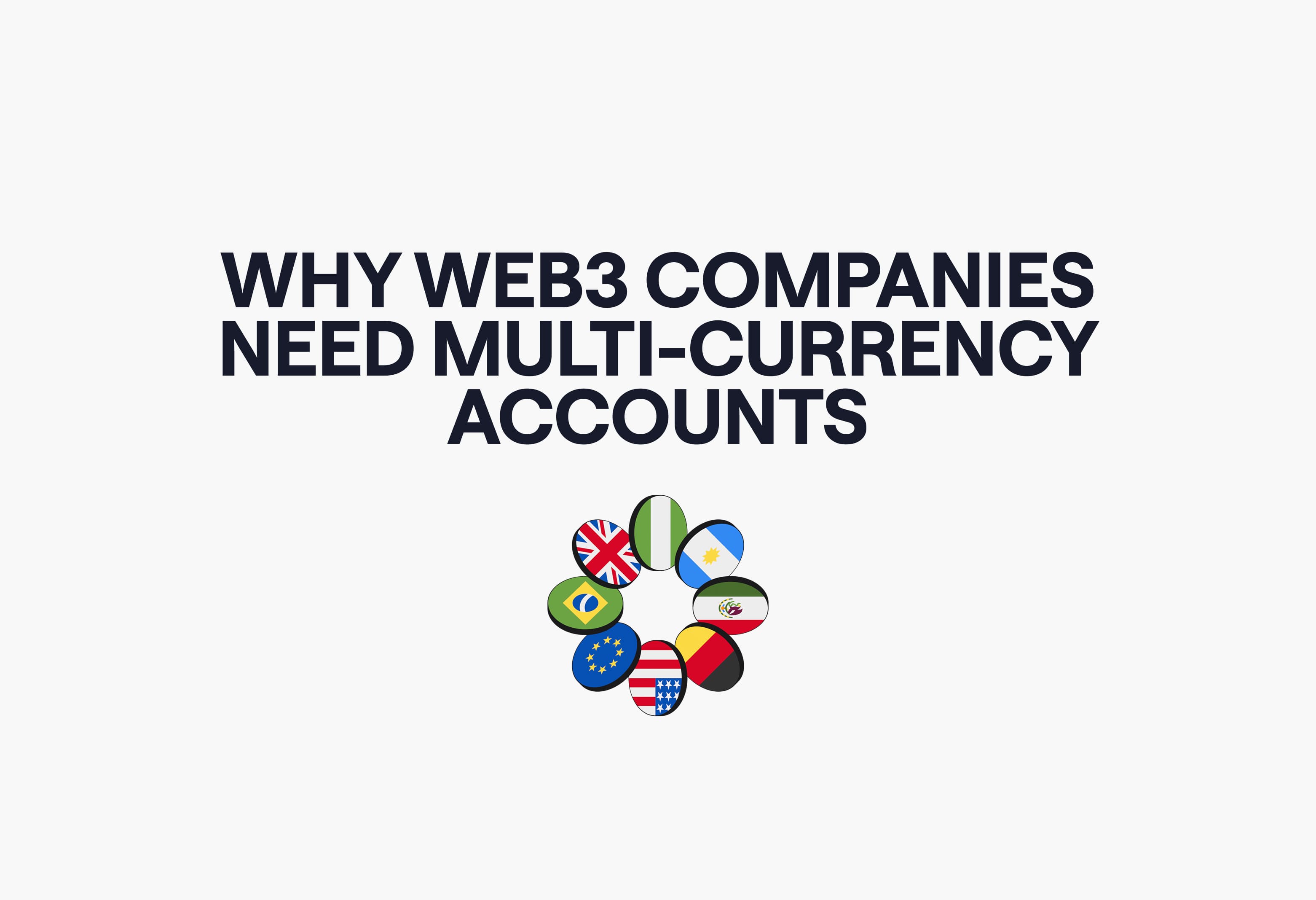
Web3 teams move capital across chains and borders daily, yet the financial infrastructure they rely on is still fragmented. Traditional banks handle digital assets poorly: transfers take days, FX spreads cut margins, and onboarding remains inconsistent across regions. Treasury ends up scattered between wallets, bank accounts, and manual reports.
A team raises funds in USDC, pays contributors in EUR, and settles vendors in USD. Each transaction requires separate tools, multiple intermediaries, and unnecessary FX costs, slowing execution and clouding visibility.
A Web3-native multi-currency account consolidates fiat and stablecoins in one place. It enables instant local and on-chain payouts, near-mid-market FX, clear compliance flows, and programmable API control, removing friction from cross-border operations. For treasurers, US- and EU-denominated liquidity matters: the dollar still anchors ~57–58% of global reserves (euro ~20%).
Due offers borderless Web3 companies multi-currency accounts with virtual local details, 80+ market coverage, 170+ wallet compatibility, stablecoin <> fiat routing, and a full Stablecoin Payments API, or just use the Business Dashboard.
The global nature of Web3 businesses
Web3 teams are inherently international. They form communities, ship products, and move value across borders without friction at the network level, but the same cannot be said for their financial operations. Managing treasury across jurisdictions, currencies, and payment rails is still complex and time-intensive.
Borderless communities, borderless finance
Your DAO votes 24/7, your contributors ship from Lagos, Lisbon, and Lahore, and your marketplace clears in minutes across wallets. Operations are global by default. Practically, that means handling income and payouts across cross-border transactions, in dollars, euros, pesos, naira, and in USDC, USDT, and EURC.
A multi-currency account for Web3 collapses that sprawl into one pane of glass: one set of APIs, local bank details where they matter, and stablecoin rails when speed and cost set the tone. On Due, that looks like virtual accounts for EUR/GBP/USD/MXN/AED/BRL and more, with local rails in 80+ markets and 40+ currencies.
Treasury complexity
Revenue often lands in stablecoins (marketplaces, protocol fees, NFT settlements). Expenses, payroll, legal, vendors, still skew fiat. A multi-currency structure allows you to segregate coin and currency balances, perform time conversions, and automate rebalancing.
Due’s API supports holding and swapping stablecoins (USDC/USDT 1:1 with zero slippage; converting into majors like EURC at market FX), so finance teams manage risk without micromanaging wallets.
Traditional banking barriers
Legacy banks are built for predictable flows: salaried payrolls, card settlements, and invoice finance. Crypto-native revenues, DAO treasuries, grant disbursements and episodic cross-border payouts don’t fit that mould.
From a risk lens, those patterns trigger enhanced due diligence, manual reviews and “de-risking” (relationship off-boarding) across correspondent chains, slowing onboarding, constraining limits and inflating spreads. International bodies have warned for years that blanket de-risking isn’t good policy, yet it persists in pockets of the system, narrowing access and raising costs for legitimate firms.
Where friction actually shows up:
- Onboarding drag: crypto-exposed businesses are routed into extended KYB/EDD cycles; counterparties in the chain (correspondent and respondent banks) may each retest source-of-funds and sanctions controls. False positives stall or reroute payments; some corridors are capped or refused outright. Supervisors keep urging “manage risk, don’t avoid it,” but practice lags policy.
- Policy asymmetry for virtual assets: the FATF Travel Rule and VASP supervision are maturing, but implementation is inconsistent across jurisdictions. That asymmetry makes banks more conservative toward DAOs and stablecoin receipts, even when flows are lawful and well-documented.
- Cut-off times & pre-funding: legacy rails observe banking hours, end-of-day cut-offs and occasional pre-funding in nostro/vostro accounts, creating timing risk for payrolls, vendor runs and grant rounds that Web3 communities expect to clear in minutes. Even as SWIFT moves to tighten retail rules on price/speed transparency, the upgrade is gradual and not universal on day one.
Common financial challenges for Web3 companies
Cross-border payouts to teams and contractors
Paying a core team in the EU, moderators in LATAM and auditors in APAC demands reliable rails with predictable timing. Due supports local payouts in 80+ markets and SWIFT coverage to 150+ countries, with instant settlement in stablecoins where appropriate, crucial for grants, bounties and ecosystem rewards.
High FX conversion fees
Global remittance costs still average ~6.49% according to the World Bank’s Remittance Prices Worldwide; banks are the costliest channel, and regulators note that the fee/FX split is often opaque. With Due, merchant processing is typically under 1% and cross-border B2B runs ~0.2–0.3%; FX spreads are usually 0.2–0.7%, and like-for-like domestic transfers often land under $0.50 per payment.
Managing stablecoins and fiat together
The question isn’t stablecoins vs fiat; it’s both, programmatically. You might collect in USDT from retail flow, rebalance to USDC for risk/compliance reasons, and hold part in EURC to match euro costs. Due enables instant 1:1 stable-to-stable swaps (e.g., USDT↔USDC) with zero slippage and converts into majors like EURC at market rate + spread, so USDC→EURC is not a flat 1:1.
Compliance & transparency issues
Multi-entity structures amplify audit and reporting demands. You’ll need clean counterparty data, chain screening, and reconcilable statements across rails. Due’s legal pages and product copy make clear the regulated footprint (e.g., Canada MSB; EU VASP registrations) and the availability of KYC/KYB, which helps finance teams meet policy and audit needs.
How a multi-currency account for Web3 solves the pain points
Hold & transact in multiple currencies (fiat + stablecoins)
Operate one treasury that spans USD, EUR, GBP and stablecoins like USDC/EURC/USDT. Spin up local receiving details (EUR IBAN, GBP sort code/account, USD ACH, MXN CLABE, BRL PIX, NGN NUBAN) and route inward funds automatically to the preferred balance.
Reduce FX costs with borderless accounts
Consolidate FX at wholesale rates rather than through retail spreads per transaction. Due’s fair-FX and uses local rails wherever possible, cutting hops and intermediaries that add cost. For planned conversions (e.g., USDC revenues to EUR payroll), treasury can time and size conversions for better pricing.
Faster global payouts for contributors and contractors
Contributors often want the choice: bank account, mobile money or wallet. Due supports local bank transfers, mobile money in key African markets, and on-chain payouts across Ethereum, Arbitrum, Optimism, Base, Polygon, Starknet and Tron, so funds arrive in minutes, not days.
Integration with digital wallets & payment APIs
If you’re crypto-native, you can accept payments from 170+ wallets (MetaMask, Coinbase Wallet and any WalletConnect-compatible wallet) and settle into USDC, while finance still books fiat where necessary. Developers integrate via REST APIs; product teams can also launch quickly with dashboard-driven payment links and virtual accounts.
Benefits of Web3 companies’ multi-currency accounts
Speed and cost efficiency
Move from T+3 SWIFT norms to near-instant settlement. A multi-currency account for Web3 routes value over local rails (SEPA Instant, Faster Payments, PIX, ACH) and stablecoin networks, so cross-border payments for Web3 land in minutes, not days. The hard numbers matter for CFOs: merchant processing typically under 1%; cross-border B2B around 0.2–0.3%; and where there’s no FX, like-for-like domestic transfers are often under $0.50.
For corridors with conversion, typical FX conversion fees (spreads) sit in the 0.2–0.7% band, five to ten times cheaper than legacy wires. The compounding effect is real: fewer failed payouts, fewer holds, better cash conversion cycles, and cleaner month-end, precisely why Web3 business banking alternatives have become operating infrastructure for growth teams. With Due, you keep the speed advantage without sacrificing auditability or controls (Business Dashboard if you’re non-technical; full REST API if you are).
Scalability for global operations
As headcount and vendor lists stretch across time zones, Web3 companies' multi-currency accounts prevent account sprawl. Think of one programmable ledger spanning cross-border transactions: create virtual accounts on demand to isolate projects, regions or grant programmes; tag flows for granular reconciliation; and settle using the best available rail, bank or chain.
Enhanced compliance & KYC alignment
Centralising fiat and stablecoin accounts for Web3 gives finance a single source of truth for counterparties, flows and approvals. Instead of juggling digital wallets vs bank accounts for Web3, you align everything behind one KYC/KYB perimeter with traceable on- and off-ramps.
Due operates with named registrations (e.g., MSB/VASP), screens transactions, and issues exportable statements that marry on-chain and off-chain activity, so auditors see a coherent picture and operations keep moving. Role-based access, address books, and approval policies (implemented on your side via API) mean you can mirror governance, multi-sig for grants, maker-checker for large vendor runs, without slowing day-to-day execution.
The result: faster onboarding, fewer compliance escalations, and evidence you can put in front of a board without flinching.
Improved crypto treasury management for DAOs and protocols
This is where the hybrid model sings. Split core reserves from working capital; keep runway in stables, fund fiat obligations just-in-time, and automate rebalancing rules that match real spend.
Due supports treasury flows for DAOs with USDC, USDT and EURC alongside major fiats. You can open a virtual EUR account tied to an EURC wallet, mint/redeem EURC↔EUR at 1:1, and rebalance USDC↔EURC at market rate + spread (no artificial 1:1 there). For global grants, bounties and ecosystem incentives, push Web3 global payouts directly to wallets or local bank accounts from the same place.
Gas sponsorship removes the need for contributors to hold native gas, while delegated wallets keep actual signing keys with your team. In practice, that’s fewer moving parts, clearer risk, and a treasury that finally reflects how you operate: stablecoins vs fiat, not stablecoins or fiat.
Choosing the right multi-currency account for Web3
- Security & custody design. For Web3, custody should be a design choice, not a constraint. Teams increasingly combine non-custodial vaults with MPC (multi-party computation) and delegated signing to let end-users (or ops) hold keys, including passkey-based (WebAuthn) flows. Providers like Dfns document delegated wallets and non-custodial architectures suitable for enterprise payment experiences. If your policy is “users control funds; platform sponsors gas”, ensure the stack supports it.
- Regulatory footprint. Prioritise partners with clear registrations and disclosures. Due’s public pages reference a Canada MSB registration and EU virtual asset registrations (e.g., Spain, Bulgaria), which matter for audits and banking partnerships.
- Stablecoin coverage & fiat rails. Your Web3 business banking alternatives should support USDC/EURC/USDT across major EVM networks plus robust fiat rails (ACH, SEPA Instant, PIX, Faster Payments), with Web3 global payouts via local rails in 80+ markets and SWIFT reach to 150+ countries.
- APIs & operational tooling. Look for REST APIs with programmable payouts, virtual accounts, bulk disbursements, and clear webhooks; a business dashboard helps ops launch before full integration. Avoid vendor lock-in, design for portability of wallets and accounts.
- FX policy & transparency. Demand visibility on spreads and routing. In practice, we see like-for-like currency fees under 50 cents per transfer and FX spreads typically 0.2–0.7% for mapped corridors (your mileage will vary). Use treasury rules to batch conversions and capture mid-market pricing where possible. (Internal benchmark; verify your corridor.)
- Euro strategy (EURC). In reserves and in stablecoins, dollars dominate: the USD’s share of official FX reserves sat around 58% in 2024 (euro ~20%), per the Fed/IMF—leaving headroom for EURC growth in Web3 commerce. Market data suggests EURC’s share of all stablecoins remains well below 0.5%, which is why euro rails can be a differentiator for EU-heavy cost bases.
- Gas experience (optional). If you want to abstract fees for users, implement gas sponsorship (paymasters/fee-payers); this approach is applicable to EVM chains and Solana. This keeps UX friction low for on-chain payments even when customers never hold native gas tokens.
FAQ — The Multi-Currency Accounts for Web3
Why do Web3 companies struggle with traditional banking?
Because risk policies lag behind the technology, onboarding takes months, counterparties get de-risked mid-quarter, and cross-border transactions rely on slow correspondent networks. A multi-currency account gives Web3 firms a practical Web3 business banking alternative that unifies wallets and bank rails under one set of controls.
Can Web3 businesses use multi-currency accounts for stablecoins?
Yes. With Due, you can hold USDC/EURC/USDT, swap 1:1 between stables with zero slippage, and convert to majors like EURC at fair-FX. Virtual EUR accounts can link to an EURC wallet so you can mint/redeem 1:1 against bank EUR.
How do multi-currency accounts help reduce FX fees for Web3?
By aggregating flows and executing conversions at wholesale rates rather than at retail card spreads. In practice, Due publishes ~0.2–0.3% for cross-border B2B and under 1% for merchant processing, versus 6.49% for legacy processors.
What’s the best way for DAOs to manage global treasury flows?
Map runway to currency exposure: keep operating float in stablecoins, convert to local currency just-in-time for payroll, and use virtual accounts to keep regional flows auditable. Where the DAO has euro liabilities, maintain an EURC tranche to reduce USD/EUR risk.
Are multi-currency accounts safe for crypto companies?
Safety is a function of custody design and controls. Look for non-custodial vaults, MPC wallets and delegated signing (e.g., passkeys) so end-users or designated operators hold the keys while you still automate payments. Pair that with regulated fiat rails and robust KYC/KYB.





